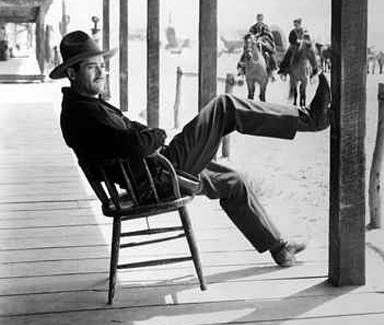Another Look: MY DARLING CLEMENTINE (directed by John Ford, 1946)

I never write trash reviews. Never. If I sit through a movie or read a book (partially read a book, I should say, inasmuch as I'm not likely to finish one I find lousy enough to be tempted to trash) I keep it to myself. In the end, any review is only one person's opinion. The same is true either way, be it positive or negative. But a positive review is attempting to encourage others to try something they might not otherwise be tempted to check out or even be aware of; a negative one is strictly a matter of discouragement and (often) ridicule. I see a big difference.
Now, having said all that, you probably already see a "BUT" coming, don't you?Well, sort of … This look at MY DARLING CLEMENTINE is more a matter of tossing out a general question, along with a few comments, as to Whythis film is so widely considered to be one of the greatest Westerns of all time. I've seen it a couple of times in the past, seen bits and pieces of it several more times over the years, and sat through it once again, beginning to end, just two or three days ago. Yes, it's directed by the legendary John Ford, it features an all-star cast headed by Henry Fonda and Victure Mature (the guy who would be playing Samson for C.B. DeMille in another three years and who was widely considered the premier Hollywood "hunk" of that era – making him the healthiest fucking tuberculosis-riddled Doc Holliday ever), and has all of the famous Ford touches, including being beautifully filmed in Monument Valley. In other words, all of the ingredients were there. Or should have been.Yet, for me, the whole thing falls flat and barely rates being a decent B-grade "shoot-'em-up", let alone anything approaching a classic. And this is just from the standpoint of storyline logic and acting.Additionally, there is the horrible mangling of the actual history of the gunfight at the OK Corral, the event which the plot is centered around. To be fair, it is oft-told that Ford got many of his "facts" from Wyatt Earp himself, on silent film sets circa the 1920s --- a point when Earp and his wife were working diligently to "clean up" Earp's image (facts be damned) for the history books and biographies beginning to emerge.

I could go on --- like mentioning the complete and utter dumbness of the title, which has not one whit to do with the film (except for an ill-fitted and meaningless female character by that name) and also totally avoids linking in any way to the famous folk song about a miner's daughter … But this isn't a trash piece, remember?
Having said what I've said, I will close with the sincere question that is truly my main point for writing this piece … What the hell am I missing? Why do so many people I admire (from Roger Ebert to Sam Peckinpah, as just two examples) consider this such a wonderful classic in contrast to the reaction of little-ol'-me?I'd really like some feedback … Convince me where I'm wrong … Or (and maybe this is my snarky true intent) let me know if there's anybody out there who agrees with my take.
Published on February 22, 2014 11:02
No comments have been added yet.
Wayne D. Dundee's Blog
- Wayne D. Dundee's profile
- 19 followers
Wayne D. Dundee isn't a Goodreads Author
(yet),
but they
do have a blog,
so here are some recent posts imported from
their feed.



